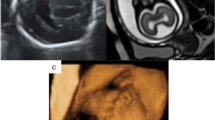Abstract
Objectives
The objective was to identify the fetal hippocampus and fornix using 2D and to measure the C-shaped length of fornix and hippocampus.
Methods
This study was designed in cross-section. Healthy singleton and between 18 and 24 weeks of gestation pregnant women who applied to the perinatology outpatient clinic for second-level ultrasound scanning between December 2022 and February 2023 were included in the study. Patients were screened consecutively. Demographic information of the participants was obtained and an ultrasound scan was performed. The fetal fornix–hippocampus’ length and hippocampal height were measured in the sagittal section. Data were presented as mean ± standard deviation, median (min, max), or number (percent).
Results
A total of 92 patients were included in the study. Fetal fornix and hippocampus measurements were taken in % 97.8 (90/92) patients. The mean of the fetal fornix–hippocampus length and fetal hippocampus height of 90 patients were measured as 35.6 ± 3.0 and 4.7 ± 3.9, respectively.
Conclusion
Fetal fornix and hippocampus can be visualized in easily with two-dimensional ultrasound during anomaly scanning in the second trimester.





Similar content being viewed by others
References
Felten DL (2006) Part III: systemic neuroscience. Section C: autonomic, hypothalamic, and limbic systems, Netter’s Atlas of human neuroscience. WB Saunders Co, Philadelphia, pp 106–112
Weinstock M (2008) The long-term behavioural consequences of prenatal stress. Neurosci Biobehav Rev 32(6):1073–1086
Fanselow MS, Dong H-W (2010) Are the dorsal and ventral hippocampus functionally distinct structures? Neuron 65(1):7–19
Baker LL, Barkovich AJ (1992) The large temporal horn: MR analysis in developmental brain anomalies versus hydrocephalus. Am J Neuroradiol 13(1):115–122
Duvernoy HM (2013) The human hippocampus: an atlas of applied anatomy. JF Bergmann-Verlag, Berlin
Sasaki M et al (1993) Hippocampal sulcus remnant: potential cause of change in signal intensity in the hippocampus. Radiology 188(3):743–746
Humphrey T (1967) The development of the human hippocampal fissure. J Anat 101(Pt 4):655
Kier EL et al (1997) Embryology of the human fetal hippocampus: MR imaging, anatomy, and histology. Am J Neuroradiol 18(3):525–532
Sylvester P (1983) The hippocampus in Down’s syndrome. J Ment Defic Res 27:227–236
Gindes L et al (2011) Identification of the Fetal hippocampus and Fornix and role of 3-dimensional sonography. J Ultrasound Med 30(12):1613–1618
Toprak E, Işıkalan MM (2022) Ultrasonographic imaging of the fetal pyloric sphincter. J Ultrasound Med. https://doi.org/10.1002/jum.16127
Horgos B et al (2020) White matter dissection of the fetal brain. Front Neuroanat 14:584266
Montenegro M et al (2006) Patterns of hippocampal abnormalities in malformations of cortical development. J Neurol Neurosurg Psychiatry 77(3):367–371
Jacob FD et al (2011) Fetal hippocampal development: analysis by magnetic resonance imaging volumetry. Pediatr Res 69(5):425–429
Funding
The authors declare that no funds, grants, or other support were received during the preparation of this manuscript.
Author information
Authors and Affiliations
Contributions
All authors contributed to the study conception and design. Material preparation, data collection and analysis were performed by [ET] ve [HBS]. The first draft of the manuscript was written by [ET] and all authors commented on previous versions of the manuscript. All authors read and approved the final manuscript.
Corresponding author
Ethics declarations
Conflict of interest
The authors have no relevant financial or non-financial interests to disclose.
Ethical approval
This study was performed in line with the principles of the Declaration of Helsinki. Approval was granted by the Ethics Committee of University Karatay.
Consent to participate
Informed consent was obtained from all individual participants included in the study.
Additional information
Publisher's Note
Springer Nature remains neutral with regard to jurisdictional claims in published maps and institutional affiliations.
Rights and permissions
Springer Nature or its licensor (e.g. a society or other partner) holds exclusive rights to this article under a publishing agreement with the author(s) or other rightsholder(s); author self-archiving of the accepted manuscript version of this article is solely governed by the terms of such publishing agreement and applicable law.
About this article
Cite this article
Toprak, E., Sayal, H.B. Ultrasonographic imaging of the fetal hippocampus. Arch Gynecol Obstet 309, 1943–1949 (2024). https://doi.org/10.1007/s00404-023-07093-7
Received:
Accepted:
Published:
Issue Date:
DOI: https://doi.org/10.1007/s00404-023-07093-7




